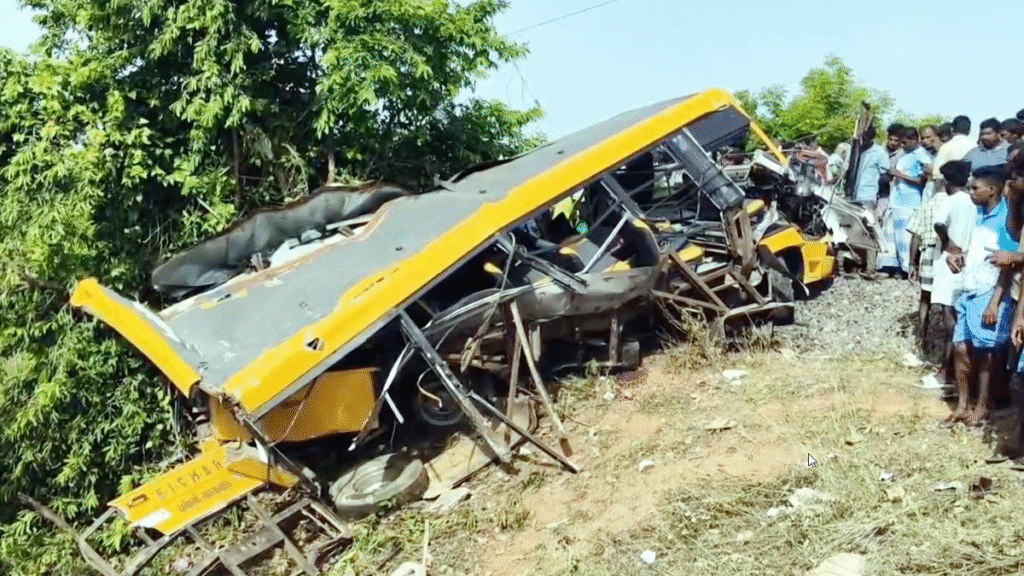
On July 8, 2025, a tragic accident in Tamil Nadu’s Cuddalore district shook the nation, prompting swift action from the Indian Railway Ministry. A passenger train collided with a school van at a manned level crossing near Semmankuppam, resulting in the deaths of three schoolchildren and injuries to six others. The incident, which occurred on the Villupuram-Thanjavur mainline section under the Tiruchi Railway Division, exposed critical safety lapses at railway level crossings, particularly those with non-interlocked systems. In response, Union Railway Minister Ashwini Vaishnaw, despite personal grief over his father’s recent passing, convened a high-level meeting on July 9 to review safety protocols. This led to the announcement of a 15-day nationwide safety inspection drive focusing on level crossing (LC) gates, alongside 11 key measures to enhance safety and prevent future tragedies. Below is a detailed examination of the incident, the ministry’s response, and the broader implications for railway safety in India.
The Cuddalore Tragedy: What Happened?

The accident occurred at approximately 95 kilometers per hour when a passenger train struck a school van carrying students from Krishnaswamy Vidyanikethan, a private school in Cuddalore district. The van, driven by C. Sankar, a driver with 15 years of experience on the route, was crossing the tracks at Semmankuppam when the collision occurred. Witnesses alleged that the level crossing gate was open at the time, raising concerns about operational negligence. Among the victims were siblings Charumathy, 16, and Chezhiyan, 15, who were seated together in the van, as well as another student. Six other students sustained injuries, ranging from minor to severe.
The Southern Railway reported that the gate was manned but non-interlocked, meaning it relied on a gatekeeper to manually open and close the gate rather than an automated interlocking system linked to train signals. A departmental inquiry, initiated on July 10 at the Tiruchi Divisional Railway Manager’s office, is being conducted by a three-member panel led by the Deputy Chief Safety Officer. The panel has summoned 13 individuals, including 12 railway staff and the van driver, to investigate the cause of the accident. Early reports suggest conflicting accounts, with some alleging the gatekeeper was negligent, possibly asleep or intoxicated, and others pointing to a language barrier, as the gatekeeper reportedly did not understand Tamil, hindering communication with locals.
Immediate Response and Compensation

The tragedy prompted swift responses from both the Tamil Nadu state government and the Indian Railways. Tamil Nadu Chief Minister M.K. Stalin announced compensation of ₹5 lakh from the Chief Minister’s Relief Fund for the families of the deceased, ₹1 lakh for those severely injured, and ₹50,000 for those with minor injuries. Southern Railway matched this with ₹5 lakh for the families of the deceased, ₹2.5 lakh for grievously injured individuals, and ₹50,000 for others. These financial measures aim to provide immediate relief, but the incident has sparked broader calls for systemic changes to prevent such tragedies.
Railway Ministry’s 15-Day Safety Inspection Drive

In the wake of the accident, Railway Minister Ashwini Vaishnaw ordered a 15-day nationwide safety inspection drive focusing on level crossing gates in block sections. This initiative, launched on July 9, aims to identify and address procedural and infrastructural gaps at the 17,083 manned level crossings across India, many of which operate without interlocking systems. The inspection, conducted by the Railway Board and zonal officials, will prioritize conflict-prone gates where public pressure or manhandling incidents have been reported. To enhance security at such locations, the ministry has directed the deployment of Railway Protection Force (RPF) or Home Guard personnel.
The drive includes daily random checks of voice recordings from non-interlocked gates to ensure compliance with safety protocols. Additionally, the ministry has mandated that Divisional Railway Managers confirm the functionality of voice logger systems at all non-interlocked gates. This measure aims to improve accountability and ensure gatekeepers adhere to operational guidelines.
Broader Implications for Railway Safety

The Cuddalore accident is not an isolated incident. In recent years, India has witnessed several high-profile train accidents, including the 2023 Balasore collision and a 2024 Mysuru-Darbhanga Express incident near Chennai, both linked to signaling and interlocking failures. These incidents highlight the urgent need for modernization across India’s vast railway network, which serves millions daily. The ministry’s push for interlocking systems and infrastructure upgrades is a step in the right direction, but experts warn that implementation must be swift and adequately funded to be effective.
The accident also underscores the human cost of safety lapses. The loss of young lives in Cuddalore has sparked public demands for accountability and reform. Local activists and grieving families have called for stricter safety measures and better communication protocols, particularly in linguistically diverse regions like Tamil Nadu.
Last Updated on: Saturday, July 12, 2025 11:33 am by Ventrapati Mahitha | Published by: Ventrapati Mahitha on Saturday, July 12, 2025 11:33 am | News Categories: News

